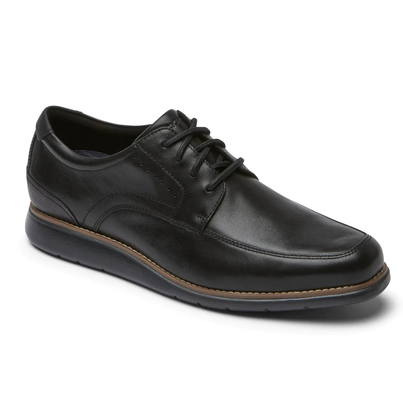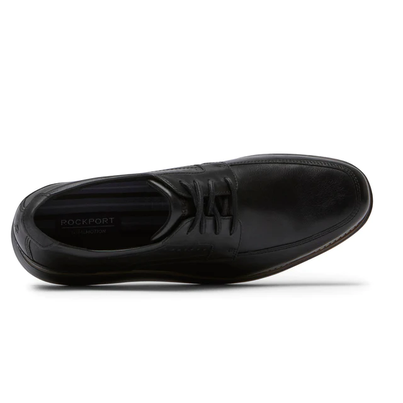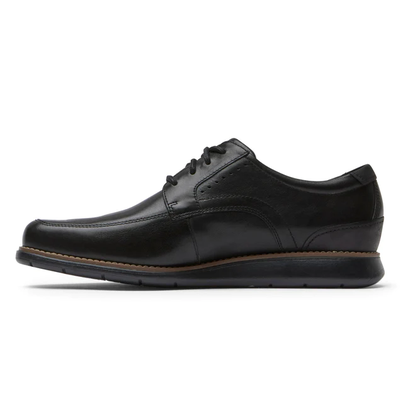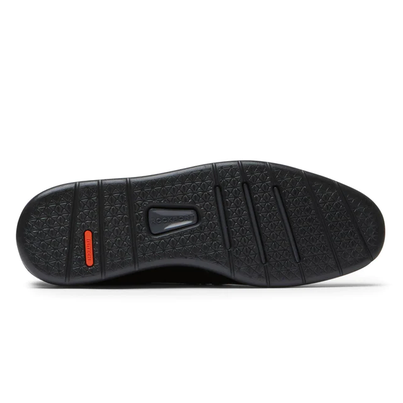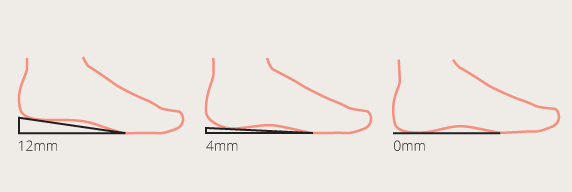$130.00
Here’s another good pick for you. Rockport Men’s Total Motion Craft Apron Toe Oxford is well made, looks clean, and can be paired with a suit or jeans.
- Injection-molded soles offer the latest in sole comfort, giving you firm yet flexible cushioning
- truTECH® provides shock absorption at the heel
- Biodewix Sanibel material with NYZM controls odor naturally
- Long-wearing rubber outsole provides a sure step on most surfaces
- Premium leather offers a luxurious touch, rich look, and lasting comfort
Injection-molded soles offer the latest in sole comfort, giving you firm yet flexible cushioning
Consistent Quality: Injection molding allows for precise control over the sole’s composition and design, ensuring consistent quality and performance across all pairs of shoes. This consistency translates into a more reliable and uniform cushioning experience.
Comfort and Cushioning: Injection-molded soles are known for providing a good balance between firmness and flexibility. They offer comfortable cushioning, reducing the impact on your feet when walking or running. The materials used can be engineered to absorb shock and offer excellent support.
Lightweight: Injection-molded soles can be made to be lightweight while maintaining their structural integrity. This reduces the overall weight of the footwear, making it more comfortable to wear for extended periods and reducing fatigue.
Durability: These soles are often made from durable materials that can withstand wear and tear, increasing the longevity of your footwear. They are less likely to break down or deform quickly, maintaining their cushioning properties over time.
Versatility: Injection-molded soles can be tailored to suit a variety of footwear types, from athletic shoes to casual and dress shoes. This versatility means that you can find comfortable soles in a wide range of styles and designs.
Enhanced Support: The injection molding process allows for the inclusion of various support features, such as arch support or heel cushioning, to address specific comfort and support needs for different activities or foot types.
Waterproofing and Weather Resistance: Some injection-molded soles can be designed to be waterproof or weather-resistant, adding to their functionality and comfort in adverse conditions.
Customization: Manufacturers can adjust the sole’s properties and design to meet the specific needs of different shoe models or sports. This customization can lead to tailored comfort and performance.
Cost-Effective Production: Injection molding is an efficient and cost-effective manufacturing process, which can help keep the cost of footwear reasonable for consumers without sacrificing quality.
truTECH® provides shock absorption at the heel
Shock Absorption: truTECH® is specifically engineered to absorb and disperse the impact forces that occur when your heel strikes the ground while walking or running. This can help reduce the stress on your feet, ankles, and lower limbs, providing a more comfortable and less fatiguing experience.
Cushioning: The technology often incorporates cushioning materials in the heel to enhance comfort. This extra cushioning can make walking or standing for extended periods more enjoyable and less taxing on your feet.
Support: In addition to shock absorption, truTECH® may offer some degree of arch or heel support, which can be beneficial for individuals with specific foot conditions or those who require extra stability.
Reduced Foot Fatigue: The shock absorption in the heel area can help reduce foot fatigue, making it a great choice for people who are on their feet for long hours or engage in high-impact activities.
Improved Comfort: The combination of shock absorption and cushioning provides an overall improvement in comfort, which can be especially appreciated by those with sensitive or achy feet.
Versatility: truTECH® technology can be incorporated into a variety of footwear styles, making it suitable for both casual and athletic shoes, as well as dress shoes, ensuring that comfort and shock absorption are available in a wide range of situations.
Please note that the specific design and performance of truTECH® technology may vary by Rockport shoe model and over time as new iterations are developed. When considering footwear with truTECH® technology, it’s a good idea to check the manufacturer’s product descriptions and customer reviews to understand the exact features and benefits offered by a particular shoe.
Pair any of them with a slick suit, holster and firearm and you’re on your way to being James Bond. Well, almost…
In a few movies, the bad guy easily identifies the good guy who is wearing a suit. The good guy asks, “How did you spot me? I’m wearing a nice suit.” The bad guy says, “The cheap shoes you’re wearing make you look like what a cop would wear.” You want to stand out for being stylish, and not for lacking it! Check out the shoes we listed in our article.
Boots, jackets, pants, shirts, guns, and sights, you name it and the tactical world sells it all. Or do they? When it comes to ‘tactical’ footwear there are a lot of boots to select from but in the realm of dress shoes the choices are very limited. In the 2004 movie Collateral the actor Tom Cruise does an excellent job mowing people down all while dressed in a slick looking grey-tonic suit. We never get to see his footwear.
How do you determine what is a good shoe for your foot and for your purpose?
Although the pickings seem to be slim the shoe market is catching up with the demand for a functional, stylish shoe that doesn’t sacrifice comfort over utility. Standing for hours in a suit and tie, running along a motorcade, and having to fight, scuffle, or run at the drop of a hat require you to be trained and outfitted properly. Hopefully, you look cool doing those things. I do not buy a suit, jeans or shoes that I cannot run or fight in.
Look at this image of Bond against his aggressor. They look stylish however they are wearing soft soled, flat-bottom shoes (without heels) for the stunts or for the style.
Bond’s dress pants are also rolled; it appears this is done so that he could perform the stunts. I’m going to assume his shoes were selected for the same reason; comfort and function. Even heroes need some help. Read my article on selecting dress pants.
You do not want your aggressor to have the advantage, whether you are the groomsman at a drunken wedding, or wrestling security while being the drunken groomsman at a wedding, or while on duty as a protective agent guarding your client at a drunken wedding. Think about the kind of ground your feet will encounter while in the line of duty:
- Snowy and icy conditions.
- Drink covered dance floor or hotel lobby with marble tile.
- Muddy conditions while changing a flat tire.
- Scree, and any kind of loose soil.
- Oil stained parking lot.
When purchasing footwear always look for ‘dress’ shoes with good traction ability. In fact, to do your job well, you will need a good pair of shoes with a lot more features than just traction. So how do you determine what are the best shoes for your feet?
The word “tactical” is way overused. A search online for tactical dress shoes turns up very little. Look for dress shoes with a good outsole. Look for good footwear that can be worn with formal, semi-formal or even casual wear. A combination of a good shoe and a reliable shoe insert will get you closer to your goal of a “tactical” shoe and get you away from the clunky styles prevalent in the marketplace.
Make sure your purchase is based on these features:
Look for shoes that have a low, and wide profile heel or outsole. Shoes with a thicker, stiffer heel heighten the probability of rolling your ankle when pursuing or wrestling your opponent. Stiffness in the upper and the outsole also make it harder to run. Responsiveness is key. Remember, low-heeled, softer outsole shoes are safer and more comfortable; they’ll do better for you than higher-heeled shoes. The more surface area touching the ground the better.
I’ve written a lot about the benefits of using shoes with a non-elevated “zero-drop” heel for proper posture. The drop is the height differential between where the heel and forefoot sit. Most dress shoes have a “high” drop between 12 and 15 mm. Many running shoes have drops that are a “zero” drop (no heel), or usually between 4mm-8mm. You essentially want a shoe that mirrors the shape and therefore the responsiveness of a running shoe. The higher the drop of the shoe or the thicker the heel of the shoe will mean the shoe is not as responsive to your toe-off when moving to spring or pivot to react to an aggressor.
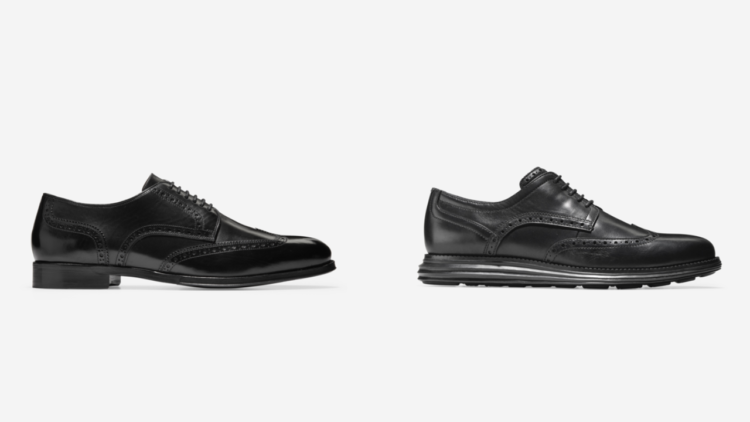
AGILITY: Stay with shoes that have a rubber or EVA foam outsole instead of a leather outsole. Rubber or EVA foam mean comfort and they lessen the chance of you slipping; particularly on marble or high shine floors. The best “tactical” shoe will have a cushioned rather than hard outsole that flexes in all directions the way that your foot does. This will give you freedom to move despite most obstacles. Rubber or foam outsoles put a spring in your stride and provide all day support.
COMFORT AND INSERTS: Look for shoes with good outsoles for added cushioning. Look for good memory foam insoles if possible. Good cushioning, whether foam or rubber, ensure you can stand or move for long periods of time. Good shoes reduce foot fatigue. EVA outsoles provide better shock absorption than rubber. A padded heel-collar helps prevents blisters. A good heel cup will cushion your heel. Take a look at the Superfeet brand if you get a chance. If they fit in the shoe give them a try for added comfort.
STYLE: You want to look sharp and have a professional profile. You want good leather that give the shoe a nice appearance and will take a shine. Full-grain leather is easiest to clean and maintain and it will extend the product life. If you don’t like leather, look for synthetics or a durable suede.
STABILITY and FIT: A high density collar provide a good heel lock while also being supple enough to provide all day comfort. A shoe with a shallower fit or collar, especially slip-ons can come off the heel when you run. Your heel should fit comfortably in the shoe with a minimal amount of slippage. The shoes should not ride up and down on your heel when you walk. Try to purchase shoes that use shoe-strings or shoes with a good, heel encapsulating collar. Premium materials give you a glove like fit. A padded heel-collar can prevent blisters. Slip resistant or oil resistant soles are a must.
When a load is applied to your foot by running, your foot will spread up to half an inch in length. One shoe size up is only 1/3″ inch larger. Go larger rather than smaller if you can. You can always wear thicker socks with a larger shoe but you can never make your foot smaller. Get the best fit.
WEIGHT: Go for lightweight, and check for tough material. Thin material can tear at the most inopportune moment. Buy the best that you can afford.
DURABILTY: Look for shoes with anti-microbial linings as they help reduce foot odor and will wick moisture to help keep the foot dry. Synthetic uppers will often dry more quickly than leather but depending on the material used, some can degrade more quickly than others. A good quality leather or synthetic upper will last a long time. Strong material will protect your feet. Some shoe brands have inner toe caps or some kind of reinforced toe guard.
- Have your feet measured. People’s feet size and shape can change over time. Don’t rely on the fact that you have always worn a certain size.
- Most people have one foot that is larger than the other, so make sure you have BOTH feet measured. Fit your shoes to the larger foot.
- Take your time and try several shoes on, preferably at the end of the day when your feet are most flattened and swollen.
- Try on shoes with the type of sock that you will wear for your activity.
- Walk on a firm surface, not a carpeted one.
- Walk quickly in the shoes if you are able.
- Don’t plan on the shoes stretching over time; they should fit well when you buy them. Shoes won’t stretch like pants or shirts do overtime.
- Pivot in the shoes.
- Always stand and walk around in the shoes to see if they are comfortable, fit well, and don’t chafe or rub anywhere. Your heel should not slip or slide while walking.
